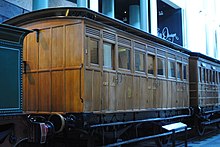Powerhouse Museum
[2] The Ultimo building, designed by Lionel Glendenning for the Australian Bicentenary in 1988, won the Sir John Sulman Medal for architecture.[6] Maiden commenced rebuilding the collection, but for the subsequent decade the new museum found itself housed in a large tin shed in The Domain, a facility it shared with the Sydney Hospital morgue.As time passed, its name was changed to The Museum of Applied Arts and Sciences and it also established branches in some of New South Wales' main industrial and mining centres, including Broken Hill, Albury, Newcastle and Maitland.[citation needed] It also quickly outgrew the main Harris Street site and by 1978 the situation had become dire, with many exhibits literally stuffed into its attic, and left unexhibited for decades.Workshops, library, storage and additional office space is located in the annexed tram sheds (still known in-house as "Stage One").The NSW Government promised to develop the new facility to international standards and engineered to present larger objects from the collection including the Catalina flying boat and Locomotive No.1[15] but proposals for lending the large items to different organisations across the state were in train since 2019,[16] and concern persisted about risks, logistics and decontextualisation of exhibits.[17] The insecurity, the "deluge of controversy" and the impact of the COVID-19 pandemic on the arts and cultural heritage sector made planning extremely difficult.[36] On 29 July 2020, the NSW government announced it had abandoned plans to relocate three of the Powerhouse Museum's biggest exhibits – the Boulton and Watt steam engine, the Locomotive No.The design of the Parramatta venue was subsequently amended by reducing the proposed presentation floor space and researcher apartments, along with a greater setback to the river.[43] In December 2023, Arts Minister John Graham announced that the Ultimo site would be closed from early February for up to three years, to allow for significant upgrades and redevelopment.[44] The statement of significance for the Federation building says the Powerhouse played a "major part in the 20th-century development of the Ultimo/Pyrmont area and in the wider heritage conservation movement in NSW."and it was part of the Darling Harbour Bicentennial citywide adaptation project, incorporated into "the transition of a major industrial location to a cultural, educational and tourism precinct".[49] The most popular exhibit is arguably "The Strasburg Clock Model", built in 1887 by a 25-year-old Sydney watchmaker named Richard Smith.[50] The Catalina Flying Boat Frigate Bird II on display in the museum is the one that Sir Patrick Gordon Taylor flew on the first flight from Australia to South America, in which he brought home 29 soldiers from New Guinea in 1945.After involvement in the air-sea rescue squadron, the museum's specimen flew from the Rose Bay flying boat base across the Pacific Ocean on the first uncharted air route between Sydney and Valparaiso, Chile.[51] The use of Catalina flying boats by Qantas Empire Airways after World War II was significant in the development of Australia's commercial air services.There is a house setup called Ecohouse where people toggle light variables to see the outcome as well as other energy use simulators and a 'ecological footprint' game.Built at a cost of A$12 million, this facility consists of seven huge sheds, including one the size of an aircraft hangar, within which are housed artefacts as a section of the mast of HMS Victory, Nelson's flagship at the Battle of Trafalgar, and the spare wheel from Bluebird-Proteus CN7, the car Donald Campbell drove to break the world land speed record on Lake Eyre in the 1960s.













Locomotive No. 1Greater SydneyNew South WalesHarris StreetUltimoObservatory HillCastle HillCoordinatesTechnology museumNew South Wales GovernmentSydneyGovernment of New South WalesUltimo, New South WalesSydney ObservatoryParramattascience museumdecorative artssciencecommunicationtransportcostumefurniturecomputer technologyspace technologysteam engineselectric trampower stationInner WestFederation-styleLionel GlendenningAustralian BicentenarySir John Sulman MedalWhitbread EngineBoulton & WattSydney International Exhibition of 1879Melbourne International Exhibition of 1880Garden PalaceRoyal Botanic GardensAustralian MuseumJoseph Henry MaidenstatueelephantgraphiteThe DomainSydney HospitalmorgueSydney Technical CollegeBroken HillAlburyNewcastleMaitlandPremierNeville WranUltimo Power StationUltimo Tram DepotJoseph Wright and SonsSaltleyState GovernmentCatalina flying boatimpact of the COVID-19 pandemic on the arts and cultural heritage sectorgreen banConstruction, Forestry, Maritime, Mining and Energy UnionNew South Wales Nurses and Midwives' AssociationSmithsonian museumsimpact of the COVID-19 pandemic on the arts and cultural heritageJohn Grahampublic squareThe Goods LineCentral StationLisa HavilahCarriageworksrotative steam engineBoulton and WattWhitbreadHistoric Mechanical Engineering LandmarkAmerican Society of Mechanical Engineerssteam locomotiveRobert Stephenson & CompanyStrasbourg astronomical clockStrasbourg CathedralPatrick Gordon TaylorNew GuineaWorld War IIRose Bay flying boat baseValparaisoQantasLocomotive 1243Steam Locomotive No. 1243Governor of New South WalesHansom CabCatalinaFlying Doctor ServiceBoultonand WattMaudslayfairgroundbarrel organspace suitsolar timelunar phasesanalog timeMerz Telescopetime lineOlivetti ValentineMetropolitan Museum of ArtMuseum of Modern ArtCooper Hewitt, Smithsonian Design MuseumDesign MuseumVictoria and Albert Museumplasma ballMarc NewsonDoultonAustralian televisionFabergéStrictly Mardi GrasChristian DiorAudrey HepburnKylie MinogueDiana, Princess of WalesAlthorpHarry PotterThe WigglesThe CockroachesStar TrekThe Lord of the RingsStar Wars
